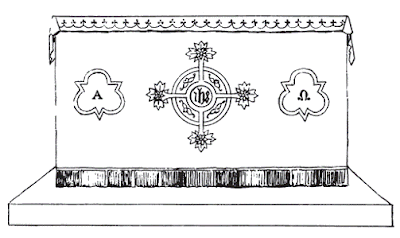Illustration: Anastacia Marice Dolby. Embroidered altar cloth design for Saints and Martyrs, 1867.
In 1867, Anastasia Marice Dolby published Church Embroidery, Ancient and Modern. The book was produced as a practical and technical guide for the use of embroidery for ecclesiastical furnishings. Although certainly pitched at an amateur audience, she did have professional help and reference guides from a number of individuals including Daniel Rock the English antiquarian and ecclesiologist who had a specific interest in church history and a practical approach to church functions such as the Mass. She is known to have used his Hierurgia or the Holy Sacrifice of the Mass, which he originally published in 1833.
Dolby also considered herself to be a professional, rather than an embroiderer of leisure, a section of society to which the book was largely aimed. She had been a court embroiderer and termed herself 'late embroideress to the Queen.' In this respect, she felt that she had the connections, professionalism and the skills base to produce a confident book concerned with the correct approach to ecclesiastical embroidery.
Illustration: Anastacia Marice Dolby. Embroidered altar cloth design, 1867.
The book itself while not giving detailed plans and pattern work as such, is largely a practical guide to church embroidery. It gives details concerning the different church furnishings that could be embroidered, including frontals, altar cloths, pulpit hangings, book covers and book marks, alms bags and chalice covers as well as a number of other textile based furnishings that could conceivably be embroidered. She also included a guide as to the type of stitching to use as well as the use of appropriate colours.
One of the sections deals with altar cloths and five examples of Dolby's illustrations for various altar cloths from Church Embroidery, Ancient and Modern are shown in this article. As far as the altar cloth was concerned, Dolby was relatively specific regarding the materials used and type of construction. She informed her readers that 'some of these cloths are now made, expressly, of fine linen damask with ecclesiastical patterns woven upon them. Others are of lawn or finest linen, and bordered by appropriate designs wrought in chain-stitch with white or coloured cotton.'
Illustration: Anastacia Marice Dolby. Embroidered altar cloth design, 1867.
As far as colour was concerned, she was even more specific, feeling that crimson and blue were considered the standard and most appropriate of colours for the embroidery of altar cloth linen in particular. She did grudgingly admit that green and lilac could occasionally be used, although she was dismissive of the colours in general. This was not through any particular ecclesiastical or spiritual reasoning. She found from personal experience that the contemporary shades produced in cotton were insufficiently attractive as well as having particular problems when being washed.
The design and pattern work was more or less universally in the medieval style, however vaguely. This is perhaps not entirely surprising for a book written in a period that was still very much considered to be within the Victorian Gothic Revival era. The previous Georgian era had been largely a classically inspired one and the ecclesiastical embroidery and indeed church interiors were organised to express that interest. However, as can be seen from the five examples, standard gothic ruled.
Illustration: Anastacia Marice Dolby. Embroidered altar cloth design for Lent, 1867.
There was a genuine need for such publications as Dolby's in the 1860s, a period which was still part of the large expansion of British and Irish church building that had begun in the 1830s. This had much to do with both the development and rapid growth of cities across Britain, with urban populations having no access to the official state church, as well as the increase in Catholic church building which had had to start from scratch in Britain when Catholics had been emancipated in 1829. Catholic church building was also expanded due to the influx of Irish Catholics into England, Wales and Scotland during much of the nineteenth century.
Nineteenth and indeed twentieth century ecclesiastical embroidery is an often neglected subject, particularly when applied to amateur embroidery. Many churches across Britain and Ireland irrespective of whether they are official state Protestant or Catholic have a wealth of embroidered samples from both centuries and any local church will probably have some embroidery work on display, usually in the form of an altar cloth. Although many nowadays tend to originate from the 1970s, these pieces are still connected to the great tradition of church embroidery that goes back centuries and was produced by countless generations of women, who although in the main amateurs, produced a skills base that was professional in all but name.
Illustration: Anastacia Marice Dolby. Embroidered altar cloth design for Lent, 1867.
Ecclesiastical Embroidery (Batsford Embroidery Paperback)
Butterick Art & Ecclesiastical Embroidery c.1898 (Metropolitan Handy Series)
Needlecraft Practical Journal #85 c.1910 - Ecclesiastical Embroidery
Sewing Church Linens: Convent Hemming and Simple Embroidery
Ideas for Church Embroidery.
Embroidery in the Church
Embroidery for the Church (A Studio handbook)
Clothed in Majesty: European Ecclesiastical Textiles from the Detroit Institute of Arts
Catalogue of English ecclesiastical embroideries of XIII. to XVI. centuries
Ancient Russian Ecclesiastical Embroideries
Designing Ecclesiastical Stitched Textiles
Church Embroidery: v. 1
Stitches for God: The Story of Washington Cathedral Needlepoint
Book of Byzantine-Ukrainian Ecclesiastical Embroidery
Parament Patterns: Counted Cross-Stitch for Altar, Lectern, and Pulpit Hangings
Church needlework ;: A manual of practical instruction
The Rise & Fall of Art Needlework
Church Needlework




